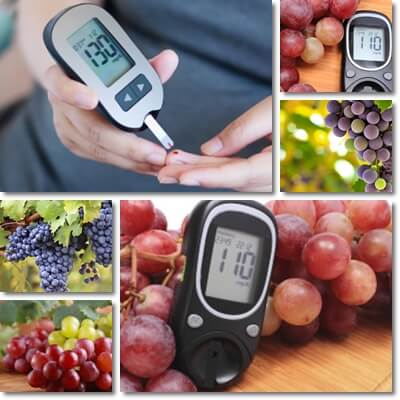Can diabetics eat grapes? Yes, diabetics can eat grapes, but only in moderate amounts as part of an overall healthy, balanced and varied diet suited to their individual nutritional requirements and the dietary restrictions of their condition. As a fruit, grapes are an important source of natural sugars, especially glucose and can raise blood sugar levels quickly if eaten in excess, too often. But what allows a diabetic person to eat grapes is the fact that they also contain dietary fiber in the skin and seeds which tempers the absorption of the sugar in the bloodstream, stabilizing the rise in blood sugar levels. Even so, it’s always best to talk to your doctor. Find out if your healthcare professional advises for or against the consumption of grapes and what is the best intake for you specifically, given your history with diabetes.
Grapes and diabetes: overview. For some time now, experts have agreed on the fact that diabetics can eat fruit, provided intake is modest and respectful of the dietary restrictions of the condition. Plenty of fruit are allowed, including grapes. Overall, you can eat grapes or other fruit with diabetes if you limit intake and number of servings so that you don’t exceed your recommended daily intake of sugars and total carbohydrates. You also have to integrate the fruit you eat into your diet wisely, for example eat a serving of grapes after a meal that provided lean protein, but little carbohydrates and sugars. This helps to both limit sugar and carbohydrate intake and prevent blood sugar spikes.

It should be noted that grapes are an important source of carbohydrates and sugar, but have a good content of dietary fiber which makes them a fruit with a low glycemic index. Actually, eating grapes is better than eating watermelon and pineapple if you have diabetes. Other biologically active elements in grapes, such as polyphenols with antioxidant and anti-inflammatory properties are believed to provide potential benefits for diabetes, such as help with weight management, reduce fasting blood glucose levels, improve insulin resistance and offer cardio-protective effects.
Grapes sugar content
Different varieties contain different amounts of sugar. If you are unsure and simply want to choose a less sugary grape, the best way to find out is to taste different varieties and observe the difference in sweetness. Also remember that the riper the grape, the higher the sugar content. The less ripe the grape, the lower the sugar content. And carbohydrates are also broken down in sugar, so look at carbohydrate content when looking to choose any fruit to eat with diabetes.
European grape varieties:
100 g of grapes has 18.1 g of carbohydrates, of which 15.48 g are sugars.
One cup (estimated at 151 g) contains 27.33 g of carbohydrates, of which 23.37 g are sugars.
10 grapes (approximate weight of 49 g) provide 8.87 g of carbohydrates, of which 7.59 g of sugar.
American grape varieties (slip skin):
100 g of grapes provides 17.15 g of carbohydrates, of which 16.25 are sugars.
One cup (estimated at 92 g) provides 15.78 g of carbohydrates, of which 14.95 are sugars.
10 grapes (approximate weight of 24 g) provides 4.1 g of carbohydrates, of which 3.9 g are sugars.
Muscadine grape varieties (not a sweet grape):
100 g of muscadine grapes gets you 13.93 g of carbohydrates
10 muscadine grapes (approximate weight of 60 g) gets you 8.4 g of carbohydrates

Grapes glycemic index: low (below 55)
The glycemic index (GI) is a number that determines how fast a certain food raises blood sugar levels. Less than 55 is low GI, between 55 and 69 is moderate GI and between 70 and 100 is high GI. Most grape varieties have a low glycemic index (less than 55, usually between 45-53), meaning they raise blood sugar levels more slowly and steadily compared to other fruits or foods. Compared to fruits like watermelon (high GI 70-75) and pineapple (moderate GI 59), grapes are a better food option for diabetes (but only when eaten in limited amounts). It helps that they contain some dietary fiber, especially in the skin, which is why it’s best to eat grapes whole, pulp and skin.
Grape juice on the other hand has a moderately high to high glycemic index (depending on the variety, whether or not it has added sugars or sweeteners, how much etc.) and is usually not good for diabetics. Actually, all fruit juices are kind of bad for diabetics and should be avoided altogether.
Do grapes raise blood sugar levels?
Despite being a fruit that is allowed in a diabetic diet within reasonable amounts, grapes do raise blood sugar levels. This is why it’s important to consume them in limited amounts and more rarely. After all, as little as 10 grapes can provide between 3.9 and 7.9 g of sugar, which is quite a lot. So yes, the sugar in grapes is bad for you if you eat too much too often. Also read Can You Eat Honey With Diabetes?
What you can do to make grapes good for diabetes (or safer to eat)
1) Eat small amounts. Calculate how much grapes you can eat with diabetes based on the recommendations for carbohydrate and sugar intake given to you by your doctor (basically count how much carbs and sugar you are allowed a day and determine how much grapes you can eat to not exceed that amount).
2) Choose less sweet varieties. Taste them in order to tell.
3) Eat the grapes whole, pulp and skin, to get some fiber, a necessary nutrient in a healthy diet.
Regular grapes provide 0.9 g of dietary fiber/100 g, while muscadine grapes 3.9 g of fiber/100 g.
4) Never eat grapes on an empty stomach.
5) Don’t eat more than one small serving of grapes a day.
6) Avoid eating grapes with other fruits (sugar adds up from all sources).
7) Ideally, eat a small serving of grapes after a lean protein meal. The protein and little fat it provides help temper the absorption of the sugar in grapes.
Also read Can You Eat Cherries With Diabetes?
Also, remember that grapes don’t treat, cure or manage diabetes – they are merely allowed in a diabetic diet in very limited amounts. Because they are a significant source of sugar, not everyone with type 1 diabetes or type 2 diabetes will have a positive reaction to eating grapes. Some sufferers might feel it’s better for them to avoid this particular fruit altogether. Which brings us to another important aspect: if you feel a certain fruit is not good for you, you experience side effects of any kind, then discontinue consumption.
As for the proposed benefits of grapes for diabetes, there isn’t really any benefit that you can get from eating grapes that you can’t get from other fruits or foods. Yes, studies show grape extract, juice and various preparations help regulate appetite, promote weight loss or at least prevent further weight gain, improve insulin sensitivity and blood glucose levels, exert antioxidant and anti-inflammatory effects with benefits for cardiovascular disease and diabetes management and prevention.
But eating grapes alone (especially in the limited amounts allowed in a diabetic diet) is not enough to produce any visible health effects or turn around the condition. One food does not undo years of bad eating, which is often the primary cause of type 2 diabetes. Diabetes is a disease of the metabolism and a complex medical condition. Its management and treatment requires an overall healthy, balanced diet (not one food), good lifestyle habits (clean eating, no drinking, no smoking), adequate levels of physical activity and long-term or lifelong treatment for more serious type 2 diabetes and type 1 diabetes.
Conclusion
Grapes are not good for diabetes in the sense that they provide benefits specifically for this condition. They don’t actually do anything for diabetes. What they are is a fruit that provides overall good nutrition which benefits health in general. But because they are a source of natural sugar, both fructose and glucose, they are best consumed in limited amounts if you have diabetes. This is because the sugar in grapes can raise blood sugar levels. As a diabetic, you are limited to a certain amount of sugars and carbohydrates a day (this determination is based on other factors as well, including weight, level of physical activity, individual nutritional requirements). So when looking to include grapes into your diet, you have to make sure the amount you eat does not exceed those recommended amounts of sugars and carbohydrates.
